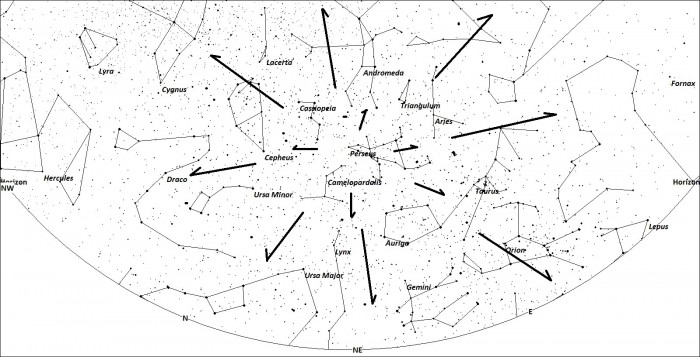
Examples of Perseid meteors as seen at 4am local daylight time while facing northeast from mid-northern latitudes.
Unlike last year when the Perseid maximum was subdued by the intense moonlight from the full moon, the Perseids in 2015 peak under ideal conditions with a new moon occurring on August 15th. Another positive note is that astronomers expect an above average display peaking over American longitudes. Another highlight is the possibility of enhanced rates for several hours centered on 19 Universal Time, which is favorable for Asian longitudes.
The Perseids first begin to encounter the Earth near July 13th, when members of this stream who have been perturbed from the main orbit first begin to appear. Rates remain below 5 per hour throughout July but then increase dramatically beginning the second week of August. Rates reach 10 per hour near August 8th and 20 per hour near the 10th. The morning of the 11th should produce rates near 30 per hour and the 12 near 50. On the night of maximum activity rates could peak anywhere from 80-120 per hour. After maximum rates fall rapidly and are back down to 5 per hour by the 17th.
The key to success in viewing the Perseids is to view from skies as dark as possible. This often means travelling to rural sites but the dramatic increase in activity you will experience is well worth it. Observers in the western portion of North America also have an added advantage of transparent skies. The dry air is more transparent compared to hazy conditions therefore fainter meteors can be seen.
On the night of maximum activity the Perseid radiant is located at 3:12 (140.1) +58. This position lies near a point where the constellations of Perseus, Camelopardalis, and Cassiopeia meet. The closest recognizable star is 4th magnitude Eta Persei, which lies 4 degrees to the southwest. The closest bright star is 2nd magnitude Mirfak (Alpha Persei) which lies 7 degrees south of the Perseid radiant. This area of the sky lies at its lowest point at sunset. Therefore the evening hours will produce little Perseid activity. The Perseid meteors you do see at this time are called “Earthgrazers” as they just skim the atmosphere above you. These meteors are few but they last for several seconds and often streak across a long portion of the sky. As the evening progresses the Perseid radiant rises into the northeastern sky and more activity will begin to appear. By midnight, the radiant will have reached a sufficient altitude to begin serious observations. The highest activity will occur between 3:00-4:00am local daylight saving time when the Perseid radiant lies highest in a dark sky. Perseid meteors will appear in any part of the sky but they will all trace back to the radiant. Not all meteors appearing that night will be Perseids. There are several minor showers also active at that time plus you can count on at least a dozen random meteors appearing each hour.
Meteor showers produce activity in “clumps”. This means that there will be periods when no activity is seen followed by periods of intense activity. This is why we urge observers to view for at least an hour so that a good sampling of activity can be seen. If you stand outside and watch for only 15 minutes, you might be watching during one of the lulls and will be disappointed with what you witness. Watching for longer periods of time ensures that you see both the peaks and valleys of activity. For extended watching it is highly suggested that you lie in a comfortable lawn chair. This will save your neck muscles and will produce a much more enjoyable experience compared to standing up.
A majority of the meteor activity seen above will occur in the lower half of the sky. The reason for this is that when viewing lower in the sky you are looking through a thicker slice of the atmosphere. Viewing straight up presents the thinnest slice of air therefore less meteors. One problem with viewing lower in the sky is that the lower portion of your field of view is wasted on the ground. The best strategy would be to view high enough in the sky so that you cannot see the ground, hills, or trees that would prevent you from seeing meteors. Aiming about half-way up in the sky is the best all around compromise for seeing the most activity.
Perseid meteors appear in all ranges of brightness ranging from barely detectable to blinding fireballs. Unfortunately dim meteors are much more numerous than bright ones. This is why we urge observers to view from dark rural locations away from city lights. The brighter Perseid meteors can also exhibit vivid colors. The colors most mentioned for the Perseids are orange and yellow. These colors are most likely produced by sodium present in the meteoroids. The brighter Perseids can also exhibit a phenomenon known as persistent trains. These appear as smoke trails that remain after the meteor has disappeared. These are not really smoke, but a column of gas that glows after the passage of the meteor. If the train lasts long enough it can be seen twisting and turning in the winds of the upper atmosphere.
While the ALPO Meteors Section urges you to view meteor activity, we also wish for you to share your experience with us. This can range from general descriptions to detailed reports on each meteor witnessed. Send your reports via email to: lunro.imo.usa@cox.net.
We look forward to hearing from you!



